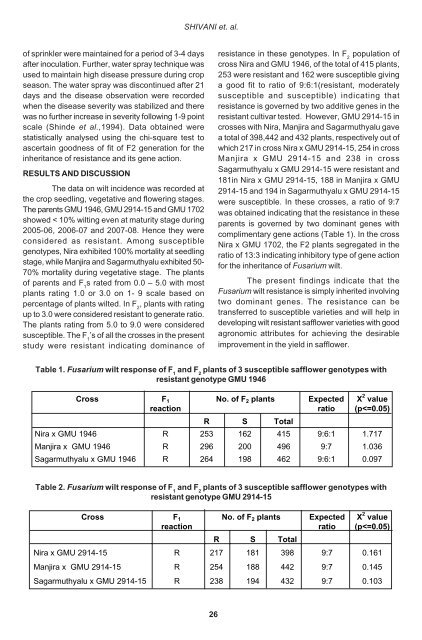physicochemical
Contents of 39(1 & 2) 2011 - acharya ng ranga agricultural university
Contents of 39(1 & 2) 2011 - acharya ng ranga agricultural university
- No tags were found...
You also want an ePaper? Increase the reach of your titles
YUMPU automatically turns print PDFs into web optimized ePapers that Google loves.
SHIVANI et. al.<br />
of sprinkler were maintained for a period of 3-4 days<br />
after inoculation. Further, water spray technique was<br />
used to maintain high disease pressure during crop<br />
season. The water spray was discontinued after 21<br />
days and the disease observation were recorded<br />
when the disease severity was stabilized and there<br />
was no further increase in severity following 1-9 point<br />
scale (Shinde et al.,1994). Data obtained were<br />
statistically analysed using the chi-square test to<br />
ascertain goodness of fit of F2 generation for the<br />
inheritance of resistance and its gene action.<br />
RESULTS AND DISCUSSION<br />
The data on wilt incidence was recorded at<br />
the crop seedling, vegetative and flowering stages.<br />
The parents GMU 1946, GMU 2914-15 and GMU 1702<br />
showed < 10% wilting even at maturity stage during<br />
2005-06, 2006-07 and 2007-08. Hence they were<br />
considered as resistant. Among susceptible<br />
genotypes, Nira exhibited 100% mortality at seedling<br />
stage, while Manjira and Sagarmuthyalu exhibited 50-<br />
70% mortality during vegetative stage. The plants<br />
of parents and F 1<br />
s rated from 0.0 – 5.0 with most<br />
plants rating 1.0 or 3.0 on 1- 9 scale based on<br />
percentage of plants wilted. In F 2<br />
, plants with rating<br />
up to 3.0 were considered resistant to generate ratio.<br />
The plants rating from 5.0 to 9.0 were considered<br />
susceptible. The F 1<br />
’s of all the crosses in the present<br />
study were resistant indicating dominance of<br />
resistance in these genotypes. In F 2<br />
population of<br />
cross Nira and GMU 1946, of the total of 415 plants,<br />
253 were resistant and 162 were susceptible giving<br />
a good fit to ratio of 9:6:1(resistant, moderately<br />
susceptible and susceptible) indicating that<br />
resistance is governed by two additive genes in the<br />
resistant cultivar tested. However, GMU 2914-15 in<br />
crosses with Nira, Manjira and Sagarmuthyalu gave<br />
a total of 398,442 and 432 plants, respectively out of<br />
which 217 in cross Nira x GMU 2914-15, 254 in cross<br />
Manjira x GMU 2914-15 and 238 in cross<br />
Sagarmuthyalu x GMU 2914-15 were resistant and<br />
181in Nira x GMU 2914-15, 188 in Manjira x GMU<br />
2914-15 and 194 in Sagarmuthyalu x GMU 2914-15<br />
were susceptible. In these crosses, a ratio of 9:7<br />
was obtained indicating that the resistance in these<br />
parents is governed by two dominant genes with<br />
complimentary gene actions (Table 1). In the cross<br />
Nira x GMU 1702, the F2 plants segregated in the<br />
ratio of 13:3 indicating inhibitory type of gene action<br />
for the inheritance of Fusarium wilt.<br />
The present findings indicate that the<br />
Fusarium wilt resistance is simply inherited involving<br />
two dominant genes. The resistance can be<br />
transferred to susceptible varieties and will help in<br />
developing wilt resistant safflower varieties with good<br />
agronomic attributes for achieving the desirable<br />
improvement in the yield in safflower.<br />
Table 1. Fusarium wilt response of F 1<br />
and F 2<br />
plants of 3 susceptible safflower genotypes with<br />
resistant genotype GMU 1946<br />
Cross F 1<br />
reaction<br />
No. of F 2 plants<br />
Expected<br />
ratio<br />
X 2 value<br />
(p
















